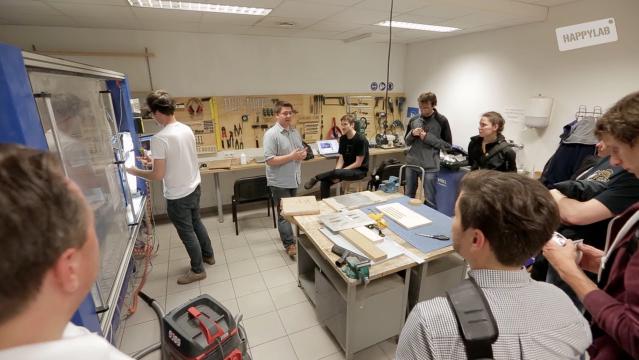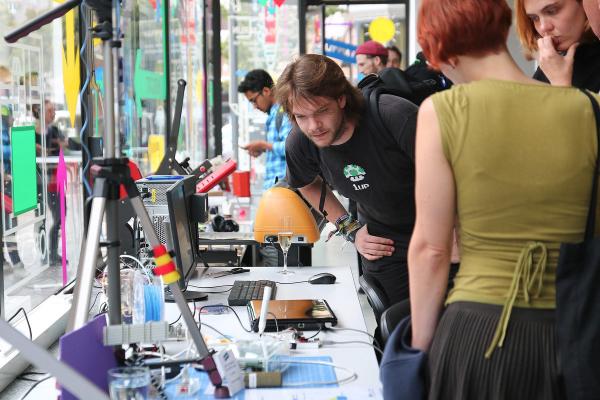Starting your own makerspace
So, you’ve decided you want to open a makerspace? Great! Thirteen years ago, Karim and I started our first makerspace, which has now grown to more than 2000 members and branched into two other cities!

Over the years, we made a lot of mistakes – but also learned a few things. In this article I’ll try to share what we know to help you kickstart your makerspace, fab lab or hackerspace.
First, define your makerspace concept and business model
Before you begin excitedly searching for a new location or machines to buy, let’s take a step back and make sure you have the basics straight:
Whom are you building this makerspace for?
This is the most important question! What audience will you cater to? Are you opening a makerspace for students? For hobbyists? For professionals? Entrepreneurs? All of the above?
Once you know the answer: find a few of them, and straight-up ask them! What are their needs and pains? Listen to what they have to say and then ask yourself: how can your makerspace match these needs? It’s never too early to start talking to your customers.
What’s your business model?
Do you want to be a for-profit or a non-profit? How are you planning to raise money? There might be funds and public loans you can apply for.
How will you get recurring revenue to keep the lights on? Will you charge a flat membership fee, charge for machine usage, add a booking fee? Will you sell materials? How will your users pay you? Cash? Is a tip jar enough or do you need to offer card payments? How will you handle billing?
Whatever you decide on, Makerspace management tools like Fabman can handle many of these aspects and help you bring your business model to life.
Don’t repeat mistakes: Connect with other makerspace owners!
Go out and take a look at what’s already there. Visit a few makerspaces and get the full tour. Have a chat with their lab managers and find out how they do things. The makerspace community is a tight-knit bunch, and usually happy to share a few “trade secrets”. Plus, it helps to compare notes, as you may potentially end up cooperating with them or complementing each other’s’ offerings. In this ecosystem, a collaborative network is far more common than stiff competition.

Location, location, location
If you feel you’ve got a solid concept for how your makerspace will work, let’s think about where! A few considerations you should keep in mind:
Accessibility – try to avoid being in the middle of nowhere. Remember your main audience and make it easy for them to reach it.
Rooms – some machines produce a lot of dirt and dust, and other machines are very sensitive to dirt and dust. Make sure your location has multiple rooms to keep these machines separated. This also helps to keep noise levels under control.
Community/Social area – While you want to isolate some equipment, a makerspace should still be an open space, welcoming to anyone and everyone who wants to build something. Think about where you could have a couch or kitchen area, and make sure you don’t have too many closed doors.
For safety, think about exhaust air. Can you direct it out of the interior without blasting it onto your neighbors?
In general, the neighborhood is an important factor. Some neighbors can be sensitive to sound or smell. Once you have chosen a location, consider inviting the neighbors over for a get-together, explain to them what a makerspace is all about, and try to get them on your side!
Teamwork makes the makerspace dream work
You’ll probably start to set up your makerspace with a few colleagues or friends. However, once your space grows, you’ll want to think about expanding that team.
One of the key roles you’ll need to fill is the lab manager – the on-site superhero. He or she is the one ensuring every machine is working, every member is satisfied, and in general, nothing is burning to the ground – which can happen. 😭 Your lab manager needs to know more about the makerspace than anyone else. They need to be someone with technical know-how and social skills. Someone with design chops, creativity, and a healthy sense of responsibility. Easy, right?
Well, at least Fabman can help you manage a huge community with just a tiny team, so you’ll only have to find one or two superheroes, not five. For instance, Happylab in Vienna keeps 1700 members happy with one lab manager. How? By letting Fabman handle membership management, access control, member training, maintenance, billing, and invoicing.
Important: Don’t forget to consider gender balance when expanding your team. Not only is this crucial for society but also for reaching a wider audience and creating a diverse, healthy community.
And remember: you can source a lot of help from your community. Many people are more than willing to volunteer their time for a cause they’re passionate about. This probably won’t replace a full-time lab manager but it can be a great help for workshops, events, and training courses.
Time for some inventory
It’s time to think about machines! Laser cutters, 3D printers, and CNC mills are the workhorses of many makerspaces. But it all depends on your target audience. Always remember what the Makerspace Playbook says:
Equipment lists are as individual as the space and its members.
This topic is complex enough to warrant its own article. Follow us on Twitter or Facebook to get notified when it’s available.
Take your makerspace to the next level
What makes great makerspaces great is not just their machines and location, but the community they’ve built. Don’t forget that as you set out to create your own. There’s no easy step-by-step guide to building communities, but some useful ideas might be:
Equipment is useless if nobody knows how to use it! Regularly hold open training sessions for anyone to take part in. This helps you grow your audience, especially if you’re the first space in your region.
Every makerspace has some version of the maker ethos - a set of rules and standards that make sure the space lives by its values such as inclusivity, learning, and sharing. Consider co-creating these rules with your first members! Have a look at the Fab Charter for inspiration.
As already mentioned, communities need community spaces. To build collaborative workspaces you should include kitchens, couches, or other relaxation areas where people can get to know each other and talk.
If it applies to your makerspace, consider stockpiling some materials that you can sell to your members when they need it.
Think about how you can attract people to your community. Host workshops and events. And consider how your makerspace appears on the outside to catch people’s attention. Grow your community organically without wasting money on advertising.
One more piece of self-promotion: Fabman can save you tons of time on tedious, boring tasks like keeping track of memberships, billing, machine maintenance, or who’s trained on which machine. You can use that saved time to engage and take care of your community!
Don’t worry if you still have lots of open questions or feel a little overwhelmed! Use the resources at your disposal, talk to people who’ve been there, and don’t be afraid to go your own path.
Looking forward to hearing from your successful makerspace in the not-too-distant future. Got questions or feedback? Leave us a comment below!